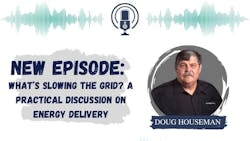T&D World Live Podcast: What’s Slowing the Grid? A Practical Discussion on Energy Delivery
In this episode of the T&D World Podcast, host Jeff Postelwait speaks with Doug Houseman, a senior managing consultant at 1898 & Co., about the current and future challenges facing the electric power sector. The conversation explores a wide range of issues, including the causes and consequences of recent large-scale power outages, persistent supply chain delays, energy transition technologies, and the need for a skilled workforce to modernize the grid.
Listen to the Episode
Houseman notes that 2024 saw nine significant blackouts across the globe, all occurring on clear, calm days — an unusual pattern that suggests deeper systemic issues. He references the Iberian Peninsula blackout in Spain and Portugal, during which gigawatts of generation capacity dropped offline within seconds. Interconnections with Morocco and France were severed by automatic protections, and it took nearly 11 hours to restore power to 99% of customers. While investigators ruled out cyberattacks, the precise cause and sequence of events remain under review.
Another major concern discussed is the extended lead time for high-voltage transformers and other essential grid components. At the height of the shortage in 2022, lead times for some transformers reached 205 weeks. As of the time of the interview, they had improved only marginally to 203 weeks. Houseman attributes the issue not just to manufacturing capacity but also to the time and effort required to train a specialized workforce. Multiple manufacturers have announced investments in new facilities, though many of these will not come online until later in the decade.
The conversation also addresses the strategic importance of reshoring electrical component manufacturing. Houseman cites recent logistical challenges — such as the temporary loss of port access in Baltimore due to the Francis Scott Key Bridge collapse — as examples of how foreign dependence can affect energy resilience. He asserts that expanding domestic production capabilities would reduce vulnerabilities in both routine and emergency scenarios.
On the topic of workforce development, Houseman points out that while there has been growth in the number of power engineering programs in North America, the supply of trained professionals still falls short of industry needs. He describes efforts to broaden the talent pipeline by hiring engineers from a variety of disciplines and retraining them in power-specific skills through accelerated programs and mentorship.
In discussing clean energy technologies, Houseman emphasizes the need to balance performance, cost, and usability. He notes that while electric vehicles (EVs) are often promoted as more efficient and cheaper to operate, adoption rates remain below expectations. Factors such as interface design and practicality for different demographics may play a role. Similarly, he explains that the economic viability of electric heat pumps varies based on climate, insulation, and local energy prices.
Houseman also challenges the assumption that energy storage is synonymous with batteries. He highlights Michigan’s pumped hydro facility as an example of effective, long-term storage infrastructure that offers reliability and efficiency without some of the safety and maintenance issues associated with large-scale battery systems.
Emerging electricity demands from data centers and other compute-intensive industries are identified as another area of concern. In Virginia and Texas alone, projected additional loads range from 9 to 20 gigawatts. Meeting these needs with renewable energy sources could require vast tracts of land, raising further questions about infrastructure, cost, and environmental impact.
The episode also touches on nuclear energy. While small modular reactors have gained attention, Houseman indicates that larger-scale nuclear may still offer a more cost-effective solution due to current regulatory conditions. On offshore wind, he notes that some projects have encountered reliability issues with large turbines, leading to delays and hesitation among investors.
Houseman concludes by noting that while federal funding and policy support have fluctuated in recent years, the greatest challenges to grid modernization may lie in execution — particularly in workforce availability, supply chain resilience, and the practical integration of emerging technologies.
You can also listen to the other episodes of T&D World Live by going to https://tanddworld.podbean.com/.
Also available on Spotify and Apple iTunes.
